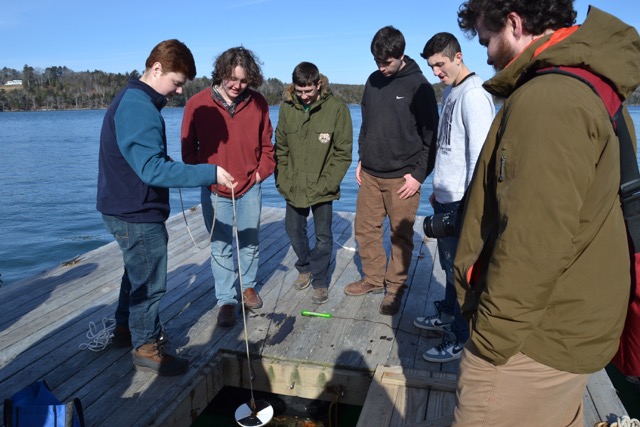
DMC and LA Teach Sensor Technology
Computer programming students in Lincoln Academy’s “Invent to Learn” class are investigating marine technology and its marine science applications, specifically aquaculture in the Damariscotta River Estuary, thanks to funding from the Sustainable Ecological Aquaculture Network (SEANET).
Using Sparkfun Inventor’s Kits the high school students are programming light and temperature sensors, push buttons, LCD screens and more. By combining these components and 3-D printing techniques, students will build sensors capable of gathering water quality data similar to that collected by SEANET buoys deployed by researchers from the University of Maine and partner institutions in the Damariscotta River.
The program is a collaboration between Lincoln Academy (LA) and the University of Maine’s Darling Marine Center (DMC) in Walpole.
Lili Pugh, DMC K-12 education coordinator, and Maya Crosby, LA’s Cable Burns Applied Technology Education Center Program Director and Technology Coordinator received a SEANET workforce development grant to introduce sensor technology and its application to high school students. The grant was designed to foster partnerships with organizations and institutions to boost K-20 STEM outreach and education programs that are aligned with SEANET’s research initiatives.
Introducing students to scientists and current research is a key part of the sensory technology program. Recently, Dr. Scott Morello, postdoctoral researcher with the Downeast Institute and based at the DMC, and Jessica Torossian, PhD student at Northeastern University, spoke to students about how mussels adapt to intertidal habitats and how scientists use “robomussels”- temperature sensors embedded in artificial silicone mussels that mimic internal mussel conditions when out in the field – to study these adaptations.
Students from three LA classes – Invent to Learn, Marine Resources, and Oceanography – visited the DMC. They toured the shellfish aquaculture facilities, learned about the Damariscotta River environment, and talked with SEANET researchers who are deploying sensors and other marine technologies to monitor oyster growth and environmental conditions.
In the end, Pugh notes, “we hope that students will gain a greater appreciation of marine technology and how it can be applied to develop creative solutions relevant to our coastal economy.”
Darling Marine Center Director Heather Leslie is delighted with the deepening partnership between the university and LA. “As the state’s flagship institution, the University of Maine is committed to sharing knowledge and tools for sustaining Maine’s marine environment and the communities that depend on it. Exposing students to marine technologies like the SEANET buoys will enable a hands-on experience with marine science and technology, and its possible impact on coastal ecosystem health. Hopefully some of these students will be inspired to study marine sciences and engineering at UMaine.”
The project is part of the Sustainable Ecological Aquaculture Network (SEANET). Support for the SEANET is provided through a National Science Foundation award to Maine EPSCoR at the University of Maine. More information about SEANET can be found here.
